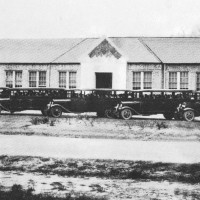
Central — Specifically Meaning the Corner of Hooper and Sullivan — Got Its Name Because It Was ‘Central’ to One-Room Schools in Area
In 1857, there were many close knit communities in the area now known as Central. Huge farms and public lands are shown on a map of that period. Some of the prominent names were Evan Vaughn, Nathan Baker, William Sullivan, Peter Delorroche, Joseph Carter, Rachael Dally, William Edwards, and others. Waterways had been named as White’s Bayou, Hurricane Creek, Comite River, Amite River, and Blackwater Bayou.
There was no consolidated school in the area and small children were taught in the homes as older children walked to near-by one room schools. Four of the longest lasting schools were Pucket on the north, Greenwell Springs on the east, Frenchtown on the south, and Woodland on the west. As the children increased and outgrew the schools, the four neighborhoods of parents agreed to consolidate their schools into one centrally-located and easily-accessible by wagon. It was decided to place the school at the junction of Settlement Road, which is now Sullivan Road, and Canal Road, which is now Hooper Road. William S. Edwards owned the property on all four corners and donated thirty acres on the southeast corner as a permanent site for the school. In donating the land William Edwards stipulated that should there cease to be a school on the property, the property would revert back to him or his heirs.
In 1884, a two-story frame building was erected by the men of the community and it was named Central High School. This was the first consolidated school in East Baton Rouge Parish and later was the first school to have a motorized school bus which was called a school van. Originally, children were transported to and from school by buggy and school wagon.
As time passed, Central outgrew the framed building and in the mid-1930’s a large brick school was constructed. The frame gymnasium, constructed earlier for boys’ basketball, was left standing. the new school boasted of adequate chalk boards, cloakroom for each spacious classroom, a complete chemistry laboratory, and home economics department. Girl’s basketball was permitted in the gym by this time.
On weekends, the school grounds became a community center where children could go to play on the grounds or shoot goals in the gym. On Saturday nights, the gym became a community meeting hall when a member of the community would travel to Baton Rouge and rent a silent movie for entertainment of the whole community. Plays and minstrels were performed on the gym stage with the actors being adults and children from the community. Later, Central began holding community dances in the gym, often with only a record player for music and using the bleachers for chairs. This continued until 1948.
Graduation has always been an exciting function at Central. Earlier classes were seated on stage in the gym for the ceremony. As the number of graduates increased, the ceremony was moved to the front porch of the gym and spectators were seated in folding chairs on the school ground.
In the 1970’s, a completely new school complex was erected on the grounds and the old brick building demolished. The old gym was preserved and continued in use. The complex as it stands today contains three classroom buildings, cafeteria, gymnasium, manual arts building, and the old gym. The facility now house the Central Middle School, and Central High School has been moved to West Brookside Drive in Central.
An anonymous history of Central schools, circa 1974.


 May 21, 2018
May 21, 2018 







Comments are closed.